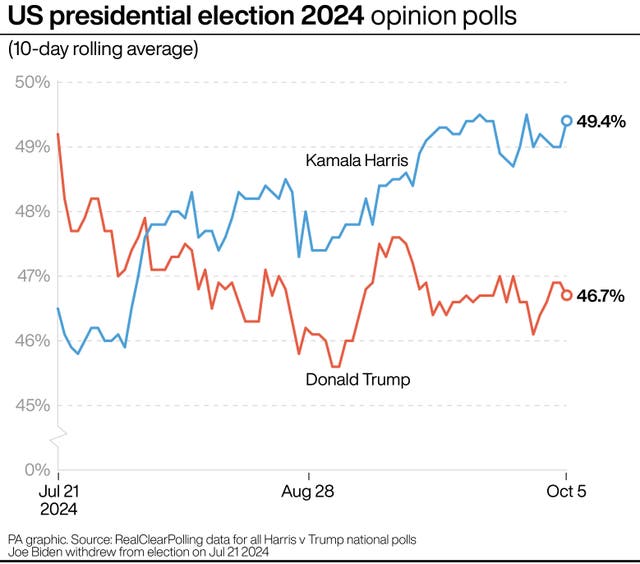Few US voters are likely to be happy with the projected higher deficits laid out in a new analysis of Kamala Harris’ and Donald Trump’s economic plans for America.
The analysis released by the non-partisan Committee for a Responsible Federal Budget suggests a Harris presidency could increase American national debt over 10 years by 3.5 trillion dollars (£2.66 trillion).
Her campaign policy guide states that Ms Harris is “committed to fiscal responsibility – making investments that will support our economy, while paying for them and reducing the deficit at the same time”.
The same analysis shows former president Mr Trump’s ideas could heap another 7.5 trillion dollars (£5.71 trillion) onto the debt and possibly as much as 15.2 trillion (£11.5 trillion). That is even though he suggests growth would be so strong under his watch that no-one would need to worry about deficits.

Total US federal debt held by the public now tops 28 billion dollars (£21.3 billion) and is expected to keep climbing as revenues cannot keep up with the growing costs of Social Security, Medicare and other programmes.
In the wake of Hurricane Helene, we are seeing the best of America.
That includes members of the North Carolina National Guard who are working around the clock to provide essential aid to communities in western North Carolina. pic.twitter.com/SSUb2oYIYN
— Vice President Kamala Harris (@VP) October 6, 2024
The analysis noted that the expense of servicing that debt in dollar terms has “eclipsed the cost of defending our nation or providing health care to elderly Americans”.
Drawing on the candidates’ speeches, campaign documents and social media posts, the analysis warns bluntly: “Debt would continue to grow faster than the economy under either candidates’ plans and in most scenarios would grow faster and higher than under current law.”
Neither candidate has meaningfully stressed budget deficit reduction in their pitch to voters. But multiple analyses show a clear difference of Ms Harris being much more fiscally responsible than Mr Trump.
Harvard University professor Jason Furman, who was the top economist in the Obama White House, estimated in an opinion article for The Wall Street Journal that Ms Harris’ plans could cut deficits by 1.5 trillion dollars or raise them by 1.5 trillion dollars (£1.14 trillion).
Meanwhile, his estimates show that Mr Trump’s plans would increase deficits by five trillion dollars (£3.08 trillion), though that figure does not include his plans to charge no taxes on overtime pay and scrap the limit on deductions of state and local taxes.

The Committee for a Responsible Federal Budget analysis estimates that Ms Harris’ policy ideas could add 3.5 trillion dollars (£2.66 trillion) to the US national debt through until 2035. That conclusion depends on its treatment of how much various programmes could cost.
It forecasts that Ms Harris would implement 4.6 trillion dollars (£3.5 trillion) in tax reductions, including extensions of some of the expiring 2017 tax cuts that Trump signed into law and tax breaks for parents and no taxes on tipped income for hospitality workers.
Roughly four trillion dollars (£3.04 trillion) in higher taxes on corporations and the wealthy would be insufficient to cover the total cost of her agenda and the additional interest on the debt that it could generate.
However, the analysis notes that its numbers depend on various interpretations of what Ms Harris has said.
What happened here in Butler, PA on July 13th was nothing short of a miracle. On that day, America felt the truth of scripture:
“Though I walk through the valley of the shadow of death, I will fear no evil, for You are with me.”
Glad to be back in Butler with @realDonaldTrump?? pic.twitter.com/28VaEmpfCu
— JD Vance (@JDVance) October 5, 2024
It is possible that Harris’ agenda would add nothing to baseline deficits, but the report also said it might plausibly add as much as 8.1 trillion dollars (£6.16 trillion) in debt in what appears to be a worse-case scenario.
By contrast, Mr Trump’s ideas would likely add another 7.5 trillion dollars (£5.71 trillion) to the debt. His 2.7 trillion dollars (£2.05 trillion) in tariff revenues would be unable to cover 9.2 trillion dollars (£7 trillion) in tax cuts and additional expenditures such as 350 billion dollars (£2.66 billion) to secure the border and deport unauthorised immigrants.
But the analysis includes other possibilities that show far higher deficits under Mr Trump. If his tariffs raised less money and there were higher costs for his mass deportations and tax breaks, the national debt could jump by 15.2 trillion dollars.
On the other hand, if the tariffs raised 4.3 trillion dollars (£3.27 trillion) and there were no costs tied to deportations, Mr Trump’s plans could only increase the debt by 1.5 trillion dollars over 10 years.






